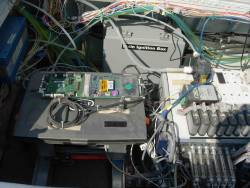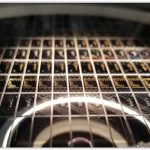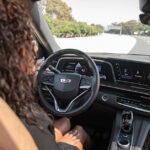 A Topcon Euro 160T mobile control board connected to a laptop computer collects satellite positioning signals used to calculate the North American Eagle’s speed. Photo: Don Talend
A Topcon Euro 160T mobile control board connected to a laptop computer collects satellite positioning signals used to calculate the North American Eagle’s speed. Photo: Don TalendA team led by led by Seattle, Washington–area aerospace and computer experts is attempting to break the sound barrier to surpass the world land speed record of 763 miles per hour — and they’re using GNSS technology to help them do it.
A team led by led by Seattle, Washington–area aerospace and computer experts is attempting to break the sound barrier to surpass the world land speed record of 763 miles per hour — and they’re using GNSS technology to help them do it.
The North American Eagle is a Lockheed F-104 Starfighter — the U.S. Air Force’s first Mach II fighter that saw service from 1958 until 1967 — on wheels.
The all-volunteer team of 44 supporting the North American Eagle Supersonic Land Speed Challenger hopes to hit the 800-mph mark in summer 2010. The Eagle’s next test run is scheduled this month (November 2009) at Black Rock Desert, north of Gerlach, Nevada.
The current record was established by British entrepreneur Richard Noble in 1997 — who exceeded the supersonic threshold by 2 mph.
To ensure that the vehicle operates as efficiently and safely as possible, the team is capturing reams of performance data from numerous sensors mounted on the car’s body. These data are coupled with position, velocity, and time (PVT) outputs from a dual-frequency Topcon GNSS receiver.
Keith Zanghi, co-owner of the car and the team’s director of operations, and Ed Shadle, the car’s co-owner, driver, and the team’s project manager, began converting a Lockheed F-104 Starfighter into a supersonic car in 1998. By day, Zanghi is a manager at The Boeing Company’s Skin & Spar (wing components fabrication) Division in Frederickson, Washington, and Shadle is a retired manager for IBM.
The 56-feet-long, 13,000-pound car incorporates extensive data-collection technology that enable the team to conduct sophisticated analyses of the car’s exterior components under realistic simulated conditions. At supersonic speeds, anticipating and controlling the car’s reactions to physical stresses are critical tasks.
“The secret with breaking the world land-speed record isn’t going fast necessarily—it’s going fast without having bad things happen,” says Steve Wallace, the team’s data-acquisition engineer, who joined the team in 2004 and analyzes machine dynamics at Boeing’s Auburn, Washington, facility for a living.
Analyzing the impacts of speed and sound on the car requires an enormous quantity of data. Wallace obtains the data from two separate information systems: a data-acquisition system and GNSS.
Twenty times a second, a dual-frequency, dual-constellation Topcon PG-A1 antenna and Euro 160T OEM receiver located behind the cockpit collect positioning signals from GPS and Russian GLONASS satellites. Wallace says that signals have been captured from as many as 14 satellites at a time.
The manufacturer says that it designed the antenna for rugged applications, making it a fit for the car’s high speeds and vibration. The antenna and a base station set up near the track simultaneously receive satellite positioning signals and work together to provide real-time kinematic (RTK) position information, revealing the car’s three-dimensional location.
A Euro 160T mobile control board, which Topcon Positioning Systems donated to the project, is mounted inside the vehicle’s electronics bay. A GB-1000 dual-constellation receiver is positioned close to the test track for the purpose of collecting static reference data. According to
Charles Rihner, vice president of planning for Topcon’s Emerging Business Unit, the board is designed according to the Eurocard standard format, i.e., its interface provides a very rugged, industry-standard adapter for computing products to withstand acceleration up to 30 G-forces. The board functions in operating and storage temperatures of minus-40 degrees Celsius (minus-104 degrees F) to 75 degrees C (167 degrees F). Rihner adds that a compact “flash” card can be used to transfer data from the board, which has a total storage capacity of one gigabyte, to a personal computer.
The data-acquisition system collects data from as many as 70 sensors mounted on critical components of the car. Wallace uses sensor data for such analyses as ensuring that the wheels are neither lifting nor burrowing into the track, or that the rear stabilizer is not vibrating excessively and causing steering problems.
Accelerometers sense vibration or acceleration. Strain gauges and piezoelectric sensors sense and send out signals indicating bending. Inertial gyros are sensors used to measure angular rates and linear acceleration on the X, Y and Z axes.
A key sensor is a pitot tube protruding from the nose cone, which has small air inlets that are used to measure air pressure and thus airspeed. Data from these sensors are stored on a laptop computer mounted behind the car’s cockpit. The team uses the data for computational fluid dynamics (CFD) analysis to ensure that the car operates with optimal aerodynamics.
Although Wallace can access the data in real time, the data are collected on board. After a test run, he downloads the data to his computer and uses Topcon Tools software to correlate the time and location data. Then he exports the data to a Microsoft Excel spreadsheet.
Each row of data in the spreadsheet reveals the interval (as time-stamped by the data-acquisition system 20 times per second) for the car to reach a series of 3-D Cartesian coordinates (as obtained by the GNSS receiver). Elapsed time is converted into miles per hour for each dimension and then the data are merged into “three-vector velocity” showing the car’s direction and speed. Wallace can use the data to generate charts showing acceleration, which may indicate how numerous components and systems on the car are performing.
By early fall 2009, all systems had been tested and the car was ready for its next test runat Black Rock Desert. The team hoped to exceed 500 mph during the test run in preparation for the attempt to break the record next year. The November 2009 test run would be the 28th since the car was first tested in Washington state in late 2005.
Author: Don Talend of Write Results Inc., West Dundee, Illinois, is a print and e-content provider specializing in covering technology and innovation.





